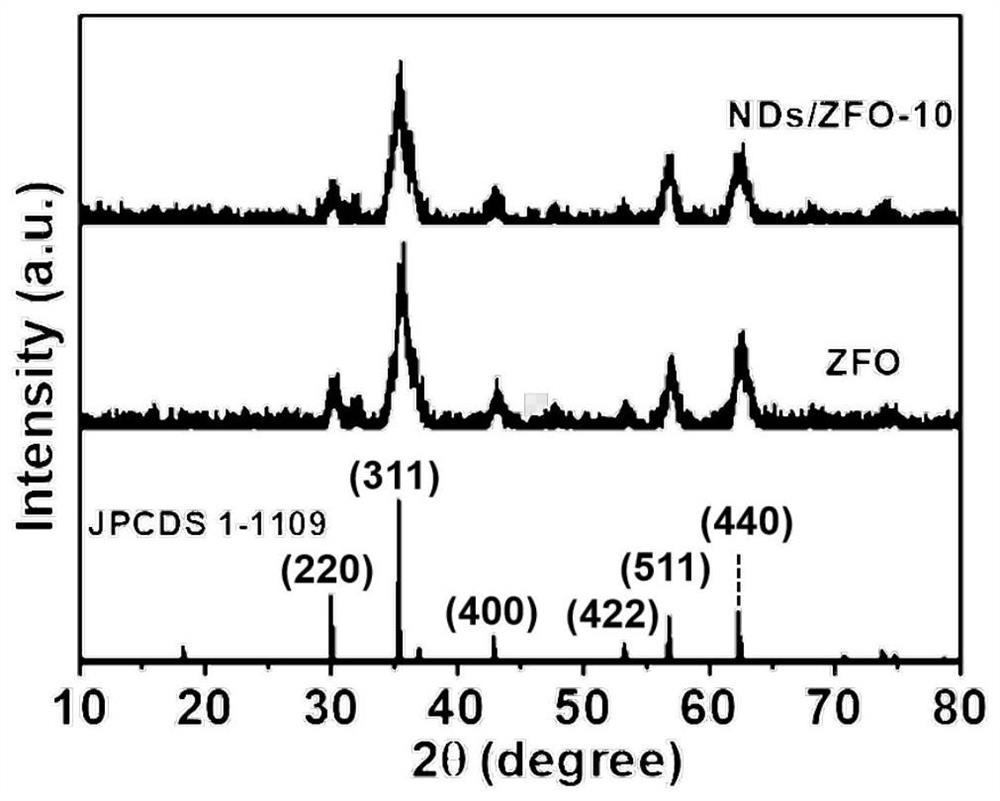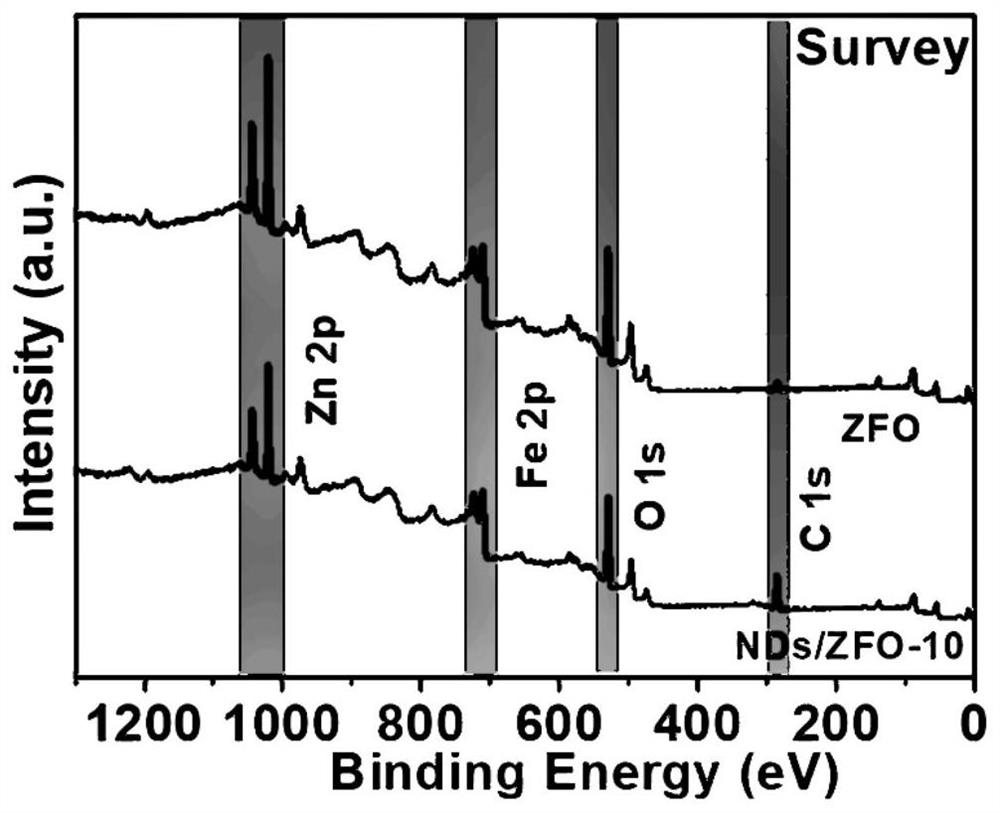Photocatalyst as well as preparation method and application thereof
A technology of photocatalyst and reactor, applied in chemical instruments and methods, physical/chemical process catalysts, metal/metal oxide/metal hydroxide catalysts, etc., can solve the problems of complex preparation process, limited potential, high cost, etc. Achieve high-efficiency photocatalytic degradation, promote separation, and low cost
- Summary
- Abstract
- Description
- Claims
- Application Information
AI Technical Summary
Problems solved by technology
Method used
Image
Examples
Embodiment 1
[0029] A photocatalyst consisting of nanodiamond NDs and yolk-shell structured ZnFe 2 o 4 , the incorporation mass of the NDs is ZnFe 2 o 4 1% of mass. Its preparation method is as follows:
[0030] At room temperature, 0.25 mmol of Zn(NO 3 ) 2 ·6H 2 O, 0.5mmol of Fe(NO 3 ) 3 9H 2 O and the theoretical formation of ZnFe 2 o 4 Add 1% of the mass of NDs into a beaker containing 50mL isopropanol and 10mL glycerin and mix well, then pour it into the reaction kettle, and react at 180°C for 6h. Wash 2 times and dry. The dried product was poured into a crucible, put into a muffle furnace, heated to 350°C at a heating rate of 10°C / min, and kept for 2 hours. After the muffle furnace was cooled to room temperature, the obtained sample was put into an agate mortar, ground to a uniform powder, collected for later use, and recorded as NDs / ZFO-1.
Embodiment 2
[0032] A photocatalyst consisting of nanodiamond NDs and yolk-shell structured ZnFe 2 o 4 , the incorporation mass of the NDs is ZnFe 2 o 4 3% of mass. Its preparation method is as follows:
[0033] At room temperature, 0.24 mmol of Zn(NO 3 ) 2 ·6H 2 O, 0.49mmol of Fe(NO 3 ) 3 9H 2 O and the theoretical formation of ZnFe 2 o 4Add 3% NDs by mass into a beaker containing 49.5mL isopropanol and 9.5mL glycerin and mix evenly, then pour it into the reaction kettle, and react at 170°C for 5h. After the reaction is completed and cooled, the mixture is centrifuged. Wash 3 times with alcohol and dry. The dried product was poured into a crucible, put into a muffle furnace, heated to 340°C at a heating rate of 9.5°C / min, and kept for 1.5h. After the muffle furnace was cooled to room temperature, the obtained sample was put into an agate mortar, ground to a uniform powder, collected for later use, and recorded as NDs / ZFO-3.
Embodiment 3
[0035] A photocatalyst consisting of nanodiamond NDs and yolk-shell structured ZnFe 2 o 4 , the incorporation mass of the NDs is ZnFe 2 o 4 5% of the mass. Its preparation method is as follows:
[0036] At room temperature, 0.27 mmol of Zn(NO 3 ) 2 ·6H 2 O, 0.51mmol of Fe(NO 3 ) 3 9H 2 O and the theoretical formation of ZnFe 2 o 4 Add 5% NDs by mass into a beaker containing 50.5mL isopropanol and 10.5mL glycerin and mix evenly, then pour it into the reaction kettle, and react at 190°C for 7h. After the reaction is completed and cooled, the mixture is centrifuged. Wash 4 times with alcohol and dry. The dried product was poured into a crucible, put into a muffle furnace, heated to 360°C at a heating rate of 9.7°C / min, and kept for 1.8h. After the muffle furnace was cooled to room temperature, the obtained sample was put into an agate mortar, ground to a uniform powder, collected for later use, and recorded as NDs / ZFO-5.
PUM
 Login to View More
Login to View More Abstract
Description
Claims
Application Information
 Login to View More
Login to View More - R&D
- Intellectual Property
- Life Sciences
- Materials
- Tech Scout
- Unparalleled Data Quality
- Higher Quality Content
- 60% Fewer Hallucinations
Browse by: Latest US Patents, China's latest patents, Technical Efficacy Thesaurus, Application Domain, Technology Topic, Popular Technical Reports.
© 2025 PatSnap. All rights reserved.Legal|Privacy policy|Modern Slavery Act Transparency Statement|Sitemap|About US| Contact US: help@patsnap.com



